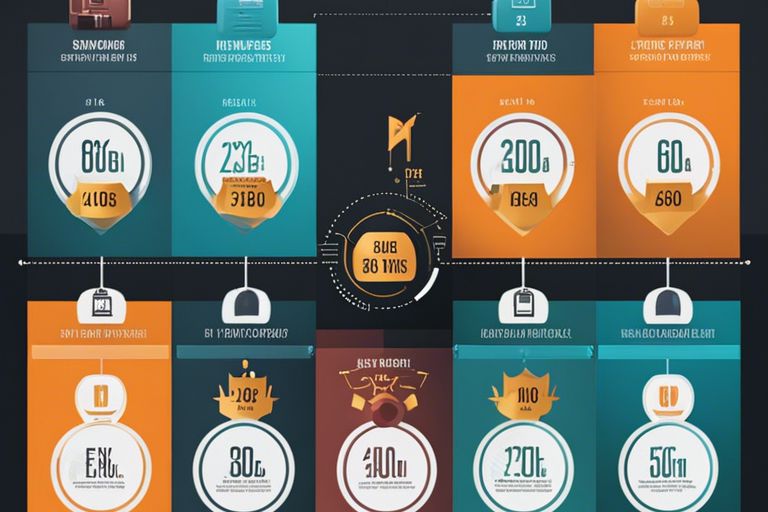Most of us find saving money to be a daunting task, but what if there was a simple rule that could make it easier? The 60-20-20 rule suggests dividing your income into three categories: 60% for expenses, 20% for savings, and 20% for investments. In this blog post, we’ll break down the math behind this popular savings strategy, showing you how it can help you achieve your financial goals faster and more efficiently.
Key Takeaways:
- 60-20-20 Rule: This savings rule suggests allocating 60% of your income to necessities, 20% to savings, and 20% to discretionary spending.
- Benefits of the Rule: Following this rule helps create a balanced budget, prioritize savings for the future, and limit discretionary spending.
- Flexibility: While the 60-20-20 rule provides a good guideline, it can be adjusted based on individual financial goals and circumstances.
The Origins of the 60-20-20 Rule
Historical context
The 60-20-20 rule for savings has a long history of financial wisdom and prudence. Understanding the origins of this rule can give you a deeper insight into its relevance and effectiveness in modern personal finance management.
Throughout history, various cultures and societies have recognized the importance of saving money for the future. From ancient civilizations to modern economic theories, the concept of allocating a portion of your income for savings has been a common practice.
The pioneers of savings allocation
For centuries, financial experts and advisors have advocated for the idea of dividing your income into different categories to ensure financial stability and security. The 60-20-20 rule, popularized in the modern era, suggests allocating 60% of your income for expenses, 20% for savings, and 20% for investments.
Understanding the context in which the pioneers of savings allocation developed this rule can provide you with valuable insights into why it has stood the test of time and remains a practical guide for personal finance management.
The Math Behind the Rule
The 60% imperative expenses
One way to understand the 60-20-20 rule for savings is by breaking down the math behind it. The first part focuses on allocating 60% of your income towards imperative expenses. These include necessary bills like rent or mortgage, utilities, groceries, and transportation costs. By ensuring that these imperatives are covered first, you can build a solid foundation for your financial well-being.
The 20% savings and debt repayment
An imperative aspect of the 60-20-20 rule is allocating 20% of your income towards savings and debt repayment. This means setting aside a portion of your earnings for future needs, emergencies, and retirement savings. Additionally, this portion can also be used to pay down any outstanding debts, helping you achieve financial freedom in the long run.
Debt repayment is a crucial part of the savings equation. By committing 20% of your income to paying off debts, you can reduce interest payments and free up more money for saving and investing. Tackling debt head-on is a proactive step towards securing your financial future.
The 20% discretionary spending
For the remaining 20% of your income, you have the flexibility to allocate it towards discretionary spending. This category includes non-imperative expenses like dining out, entertainment, shopping, and other leisure activities. While it’s important to enjoy life and treat yourself occasionally, it’s also crucial to strike a balance between indulgence and financial responsibility.
It’s imperative to exercise discipline and mindfulness when it comes to discretionary spending. By being intentional about where this portion of your income goes, you can avoid overspending and ensure that your financial goals remain on track. Keep in mind, every dollar saved today can contribute to a more secure and prosperous tomorrow.
Breaking Down Essential Expenses
Your important expenses – such as housing costs, food and transportation, insurance, and utilities – are key components of your budget that fall under the 60% of the 60-20-20 rule for savings. Let’s break down these important expenses further to help you manage your finances effectively.
Housing costs
Breaking down your housing costs is crucial as it typically represents a significant portion of your important expenses. This category includes your rent or mortgage, property taxes, homeowners’ insurance, and maintenance costs. It’s important to budget wisely for housing to ensure you can comfortably afford it within the 60% threshold of the 60-20-20 rule.
Food and transportation
Food and transportation are important expenses that can easily add up if not managed properly. When breaking down your food expenses, consider groceries, dining out, and any other food-related costs. Transportation costs should encompass your car payments, gas, maintenance, and public transportation fees.
With careful planning and budgeting, you can control your food and transportation expenses to align with the 60-20-20 rule. Meal prepping, using public transportation when possible, and regular vehicle maintenance can help you stay within budget.
Insurance and utilities
Insurance and utilities are important for protecting your assets and maintaining a comfortable living environment. This category includes health insurance, car insurance, utilities such as electricity and water, as well as internet and phone bills. It’s important to factor in these costs when budgeting your important expenses under the 60-20-20 rule.
Housing and transportation are necessities for your daily life, and it’s vital to prioritize them within your budget. By breaking down these important expenses and managing them effectively, you can ensure financial stability and work towards your savings goals.
The Importance of Savings and Debt Repayment
Not familiar with the 50-30-20 Rule? You might have come across it on r/CalebHammer. Regardless of the rule you follow, whether it’s the 50-30-20 or the 60-20-20, the common thread is the importance of savings and debt repayment for financial security and stability.
Emergency Funds
To ensure your financial well-being, having an emergency fund is crucial. This fund acts as a safety net for unexpected expenses like medical emergencies, car repairs, or sudden job loss. Experts recommend saving at least three to six months’ worth of living expenses in this fund to protect you in times of crisis.
Retirement Planning
The key to a comfortable retirement is starting to save early and consistently. The 60-20-20 savings rule allocates 20% of your income for this purpose. By investing in retirement accounts such as a 401(k) or IRA, you allow your money to grow over time, ensuring financial stability in your later years.
It’s vital to understand the power of compound interest when it comes to retirement planning. The sooner you start saving and investing, the more time your money has to grow. Even small contributions early on can result in significant wealth accumulation due to the compounding effect.
Paying off High-Interest Debt
Savings from the 60-20-20 rule can also be used to pay off high-interest debts like credit cards or personal loans. By systematically tackling these debts, you free up more of your income for savings and investments, ultimately accelerating your journey towards financial freedom.
The importance of paying off high-interest debt lies in reducing the financial burden caused by high interest rates. With less money going towards interest payments, you can redirect those funds towards savings, investments, or other financial goals, propelling you closer to financial security.
Discretionary Spending: The Fun Part
To truly enjoy life while saving according to the 60-20-20 rule, you need to allocate a portion of your budget to discretionary spending. This is the fun part where you get to indulge in activities and experiences that bring joy and fulfillment.
Entertainment and hobbies
For entertainment and hobbies, set aside 20% of your discretionary budget. Whether it’s going to concerts, movies, or trying out a new hobby like painting or cooking classes, investing in activities that bring you happiness is necessary for a well-rounded life.
Travel and leisure
For travel and leisure, allocate another 20% of your discretionary budget. Traveling allows you to explore new cultures, relax in beautiful destinations, and create lasting memories. Whether it’s a weekend getaway to a nearby town or a dream vacation abroad, prioritizing travel enriches your life in ways that material possessions cannot.
The joy of travel lies in the experiences you garner, the people you meet, and the memories you create along the way. Your travel adventures can broaden your horizons, challenge your perspectives, and provide a much-needed break from the routine of daily life.
Personal development and education
With 20% of your discretionary budget set aside for personal development and education, you can invest in courses, workshops, books, or seminars that enhance your skills and knowledge. Continuous learning not only expands your expertise but also opens doors to new opportunities and personal growth.
Spending on personal development and education is an investment in yourself. By acquiring new skills or knowledge, you are equipping yourself to tackle challenges, advance in your career, and lead a more fulfilling life overall.
Real-World Applications of the 60-20-20 Rule
Budgeting for Singles
An important aspect of the 60-20-20 rule for singles is to ensure that you are prioritizing your savings while still meeting your living expenses comfortably. By allocating 60% of your income to importants like rent, groceries, and utilities, 20% to savings, and 20% to discretionary spending, you can create a balanced budget that sets you up for financial success.
Note, the key is to be consistent with your allocations each month. This will help you build your savings over time and also enjoy guilt-free spending on things you love without breaking the bank.
Budgeting for Couples
The 60-20-20 rule can be a great tool for couples to manage their finances effectively. By working together to allocate 60% of your combined income to importants, 20% to savings, and 20% to discretionary spending, you can align your financial goals and priorities.
It’s important to have open communication with your partner about your financial habits and goals. By being on the same page and holding each other accountable, you can build a strong financial foundation for your future together.
The 60-20-20 rule can also help couples navigate joint expenses like rent, groceries, and utilities more efficiently. By setting clear boundaries and expectations for each category of spending, you can avoid conflicts and work towards your shared goals seamlessly.
Budgeting for Families
For families, applying the 60-20-20 rule can help you manage your finances while providing for your loved ones. By allocating 60% of your income to importants, 20% to savings, and 20% to discretionary spending, you can prioritize both short-term needs and long-term goals.
One of the challenges families face is balancing the needs of each family member and ensuring everyone’s well-being without overspending. By following the 60-20-20 rule, you can create a budget that addresses everyone’s needs while still saving for the future.
Summing up
Now that you have a better understanding of how the 60-20-20 rule for savings breaks down, you can see the importance of setting aside a portion of your income for different financial goals. By allocating 60% of your income for fixed expenses, 20% for financial goals, and 20% for saving and investing, you are creating a balanced and structured approach to managing your finances. This rule can help you prioritize your spending, build savings, and work towards achieving your long-term financial objectives.
Recall, the 60-20-20 rule is a guideline that can be adjusted to suit your individual circumstances and goals. By implementing this rule, you can take control of your finances, start saving effectively, and pave the way for a more secure financial future. So, start putting this rule into practice today and watch your savings grow over time!
Q: What is the 60-20-20 rule for savings?
A: The 60-20-20 rule suggests dividing your income into three categories: 60% for expenses, 20% for savings, and 20% for financial goals.
Q: How do you determine your 20% savings goal?
A: To determine your 20% savings goal, calculate 20% of your monthly income and set it aside for savings. This can help you build an emergency fund, save for a major purchase, or invest in your future.
Q: What are the benefits of following the 60-20-20 rule for savings?
A: By following the 60-20-20 rule for savings, you can achieve financial stability, build wealth over time, and reach your financial goals. This rule helps you prioritize savings and avoid living paycheck to paycheck.




